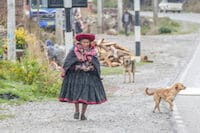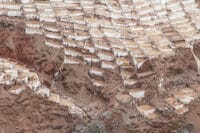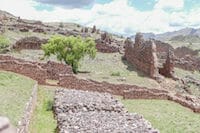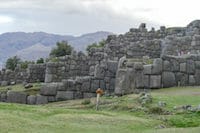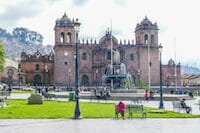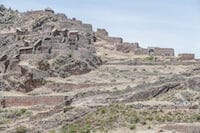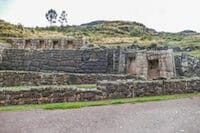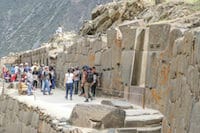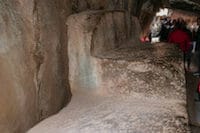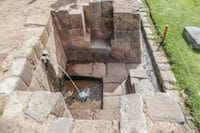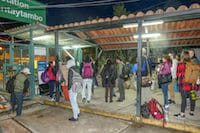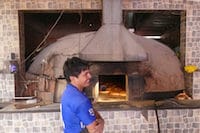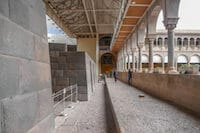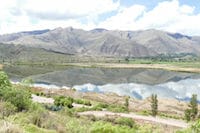Cusco PERU TOUR Review - Sacred Valley tours launch point and THE Peru city we recommend if your tour time only allows a visit to one place
Cusco, once the center of the Incan empire, is having a gold rush. The tourist in reach of the ATM is its sleeping, eating, sightseeing gold. You, the tourist, are its walking treasure.
There is nothing hidden about how important tourism is to this city. Walk out the door of your hotel and you will encounter one of the small army of traditionally garbed women in bowler hats and multi-flounced skirts with leggings. They come from surrounding rural areas to hold baby llamas OR newborn alpacas in their arms, inviting you to a pet, photo, or both. It’s non-stop, until the regular baby llama-toting denizens of your pathway see you enough times to remember you are a non-buyer, or perhaps you are inured to their look and don’t give off gawking tourist vibes. In and out of the city over the course of ten days, our strolls to get to points a or b eventually seemed to be non-events for these women in our well-worn paths, other than an occasion to return a smile. For world travelers who cringe at memories of aggressive touts that chase you ‘til exhaustion, know that this is NOT one of those places. Think more—relajado y agreable.
You also see tourism’s import to the city by the prevalence of stores selling tourista wares and fashions. With the benefit of 20-20 hindsight-- and if your tour will continue beyond the bounds of the city proper—DO look for any purchases you want to make of high end finer goods here, as the selection is good. Plan though on finding the lower priced weavings and craft goods all along your Peru tour, and even some of the finer goods, offered at lower prices directly by the craftswoman --usually a woman, with the Taqile Island exception-- or people posing as such.
While tourism is reported to be the #3 source of revenue in Peru, in Cusco-proper an educated guess is that it is #1.
Sacred Valley Tour Starts in Cusco
Cusco is your launch point for an immersion in Peruvian pre-Columbian cultures and especially the legendary Incas. You can wing it on your own, or take one of the many tours that touts are selling in its central Plaza de Armas, or referred from hotel concierge services, or pre-arranged from afar. Our tip would be to mix it up—not only between solo vs. guided, but also using a number of tour guides or services rather than relying on one. At least in the off-season, you get the picture that most of the guides are freelancers who tie their fortunes to one or another tour business on some semi-regular basis. All guides are allegedly required to have university degrees in tourism that arm them with rudiments of archeological, historical, anthropological, art history, and related fact sets. In some cases this was hard to believe, e.g. the guide who confidently claimed that all the quinoa-chomping vegan Incas lived to be 120 years of age. In most cases – and especially if we were spending more than ½ a day with a guide—they each seemed to hit a wall at some point, either with their English skills or running out of material beyond their usual narratives. There seemed to be numbers of fellow tourists on shorter timetables that had pre-arranged recommended guides for a one or two day tour in and around Cusco. They seemed quite content. On the other hand, we also ran into fellow tourists who had enlisted big name, high profile tour companies in the US, and who found their tours outsourced to less-than-knowledgeable guides, at quite a pretty penny.
CLICK THE NAME (GREEN LINK) OF THE SACRED VALLEY SITE TO READ A DETAILED PICTURE-RICH REVIEW---
You, like this writer/photographer team, may have prioritized Cusco for your tour simply because it is the way to get to Machu Picchu. Indeed it is, and if you are there in low-season, you can easily wait until your arrival in Cusco to gather a projected weather forecast before booking your entrance and train rides to Machu Picchu ,and/or the trek starting point. There is much, much more though to the Sacred Valley—Chinchero, Maras, Moray, Ollantaytambo, Oropesa, Pikillaqta, Pisac, Q’enqo, Rumicolca, Sacsayhuamen, Tambomachay, Tipón, and more, your schedule allowing.
Combining day excursions to these sites, with half-day excursions and overnights, and returning always to Cusco, in short order, the city’s familiar streets begin to feel like home.
Culture Collisions
The city itself seems like a preserved X-ray of how the Conquistadors vanquished the Inca dynasty. The colonial architecture lends the city a comfortable majesty making it a most pleasant place to just be. Taking a tour of Qoricancha early in your Cusco stay helps to raise the curtain in your mind, as the earthquakes literally have done on the ground, to see the Inca foundations of the city. You then realize that many of the towering walls along your paths date back to the Inca. An early tour of the Cusco Cathedral (Cuzco Cathedral), and especially if you enlist a tour guide who can share his or her melded Andean religion with Catholicism viewpoint, gives a peephole into pre-Columbian and Conquistador cultural collisions. When you realize the streets on your map have been re-named in Quechua tongue you glimpse how this low level combat perhaps continues in real-time.
Mix with the Locals
Though it’s clearly a tourist haven, the locals and local life are there in plain sight, even if you don’t travel to the more residential areas surrounding the tourist center. If you prefer the universal tourist diet, you will find pubs, pizza, pasta and even falafel in built-for-tourist restaurants and watering holes.
However, you don’t have to travel outside the tourist quasi-ghetto to find restaurants that the locals love, and where you will be the foreigner exception. If the number of times we found we couldn’t resist the great price (about US$3) and huge portions is any indication, our top pick would be lunch at the curiously named Ego Restaurant that brags of and delivers a home-cooking menu. Come hungry though. Most would find the large bowl of soup given to all comers as a meal in itself, yet it is a mere appetizer.
Or, venturing into a banquet-hall sized restaurant on a weekend, you too may be treated to seeing large parties of locals mix it up on the dance floor. Walk down the hill and away from Plaza de Armas just ½ a mile or so, and you can find yourself in a locals’ luncheonette where club sandwiches seem to be on everyone’s plate.
The one place where you will see wall-to-wall tourists is the Starbucks near the Plaza de Armas. It was the better wifi, not the coffee, that lured us back there daily.
The real people may have been easier to spot from the vantage point of our hotel nest, a convent atop a Catholic School – (Hostal San Juan Masias), as opposed to tourist central in the hilly San Blas area. Accommodations don’t get more basic than this, and though clean and hospitable, this would never be the top pick for anyone seeking a taste of luxury. How fun though to find yourself in throngs of school children in morning and mid-day. Schoolgirls with neat buns under lace caps make a cheerful din. At school day’s end mothers are seen being dragged to the table outside the school door to buy them sweets. And when the Peru team rendered the miracle of winning a place in the World Soccer Cup competitions, you could hear the singing from the special school assembly brought together in songs that we assume were all praise-be type tunes. One morning, we were serenaded by hundreds of tonettes trying to master a phrase of Silent Night.
Coca Culture
Landing in Cusco airport at night, it was also at this convent hotel that we first learned of the place that coca has in the culture—and by implication, just how ridiculous the US government attempts to eradicate coca are. Before asking for passports or doing any of the paperwork for hotel check-in, the attendant directs you to sit on a sofa and accept the teacups chocked halfway full with coca leaves, steeping in a splattering of hot water. This is not only your typical Cusco welcome drink, but perhaps gives hoteliers a way to make sure you aren’t going to faint with oxygen deprivation on the walk to your room. The typical (missable) Peruvian breakfast—juice/bread/butter/jam/hot water—comes with an assortment of tea bags, half of which are coca.
Coca tea turns out to be quite tasty, and not unlike a good Japanese green tea. Whether coca truly works or not at taming altitude sickness woes is another story. This writer had some headache free times, but they always seemed to be lurking in a corner ready to re-emerge. Nor did the typical diuretic pills prescribed for altitude sickness make it go away either. Do know that when you venture to Machu Picchu you are actually going to a lower altitude, albeit a site with steep hikes that will leave the non-altitude-acclimated quite breathless.
Doing the slow climb to Cusco from Lima by land over the course of several days is said to help. The cost of the plane ride didn’t seem worth it, especially when we realized rates were more than tripled for foreigners. A cautionary note to those going on to Lake Titicaca, Puno and Arequipa—you are only going higher and higher. Expect breathless hikes to be your new normal, but do know that when you get to terra firma back home you can make that hike up to your 3rd floor apartment as normally as before your Peru tour.
Market and Outside the Market
The big place to go to see the locals is the market. Tour guides caution that sanitary standards in the food stalls are non-existent, and that does seem to be the case. But how can you possibly skip making frequent trips to the fruit juice stands where you can encounter exotic fruits, with out without milk ,in shake form. This is clearly a place where the locals go too—even for the likes of llama fetuses to make ancient sacrifice offerings.
Just outside the market doors there are numbers of women holding large covered baskets of food that many locals seem to prefer. We took our lottery ticket to follow their lead. It was tasty. One of us did indeed get ill the next day, the other saving the predictable tussle with travel intestinal woes for bugs born in official Lima restaurants. The high-end foodie haunts that have put Peruvian cuisine on the short list of gourmet centers are probably hygienic to the max. Beyond those, you don’t see health department inspection sign equivalents on Cusco restaurant walls—nor anywhere else in Peru.
Museums
Cusco’s museums in the city proper can’t really compete with the archeological sites radiating out from this city that you can gain entrée to with the combined boleto turistico. If logistics, work, or other similarly keeps you in the city for a good part of a day, taking in the Inca Museum or doing the quick rounds of museums and church art collections you get to see with a combined boleto religioso is recommended. Otherwise these are relatively skippable.
Does Cusco wildly excite expat juices? No.
Is Cusco like a university without walls to learn about the Inca and their before and after? Yes.
If one had to choose only one place to plant in Peru during a 10-day or less tour, Cusco would be our top pick.
Click here to read more Low Season Travel: Peru Tour stories
CLICK THE NAME (GREEN LINK) BELOW TO READ DETAILED REVIEWS OF SITES IN CUSCO AND SACRED VALLEY



















